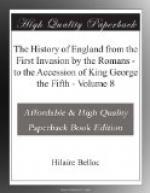Ramsay; broke them at the very onset; urged the pursuit two miles beyond Keynton, and finding the baggage of the enemy in the village, indulged his men for the space of an hour in the work of plunder. Had it not been for this fatal imprudence, the royalists would probably have gained a decisive victory.
During his absence the main bodies of infantry were engaged under their respective leaders, the earls of Lindsey and Essex, both of whom, dismounting, led their men into action on foot. The cool and determined courage of the Roundheads undeceived and disconcerted the Cavaliers. The royal horse on the left, a weak body under lord Wilmot, had sought protection behind a regiment of pikemen; and Sir William Balfour, the parliamentary commander, leaving a few squadrons to keep them at bay, wheeled round on the flank of the royal infantry, broke through two divisions, and made himself master of a battery of cannon. In another part of the field the king’s guards, with his standard, bore down every corps that opposed them, till Essex ordered two regiments of infantry and a squadron of horse to charge them in front and flank, whilst Balfour, abandoning the guns which he had taken, burst on them from the rear. They now broke; Sir Edward Varner was slain, and the standard which he bore was taken; the earl of Lindsey received a mortal wound; and his son, the lord Willoughby, was made prisoner in the attempt to rescue his father[1]. Charles, who, attended by his troop of pensioners, watched the fortune of the field, beheld with dismay the slaughter of his guards;
[Footnote 1: The standard was nevertheless recovered by the daring or the address of a Captain Smith, whom the king made a banneret in the field.]
and ordering the reserve to advance, placed himself at their head; but at the moment Rupert and the cavalry reappeared; and, though they had withdrawn from Keynton to avoid, the approach of Hampden with the rear of the parliamentary army, their presence restored the hopes of the royalists and damped the ardour of their opponents. A breathing-time succeeded; the firing ceased on both sides, and the adverse armies stood gazing at each other till the darkness induced them to withdraw,—the royalists to their first position on the hills, and the parliamentarians to the village of Keynton. From the conflicting statements of the parties, it is impossible to estimate their respective losses. Most writers make the number of the slain to amount to five thousand; but the clergyman of the place, who superintended the burial of the dead, reduces it to about one thousand two hundred men.[1]
Both armies claimed the honour, neither reaped the benefit, of victory. Essex, leaving the king to pursue his march, withdrew to Warwick, and thence to Coventry; Charles, having compelled the garrison[a] of Banbury to surrender, turned aside to the city of Oxford. Each commander wished for leisure to




